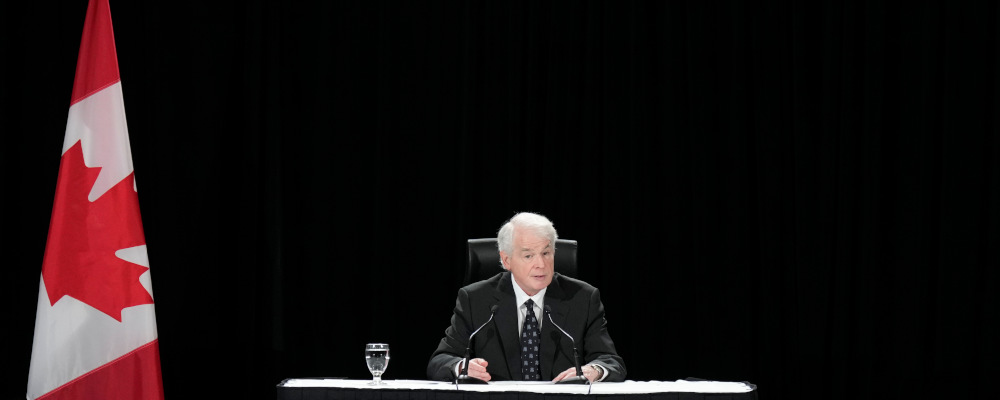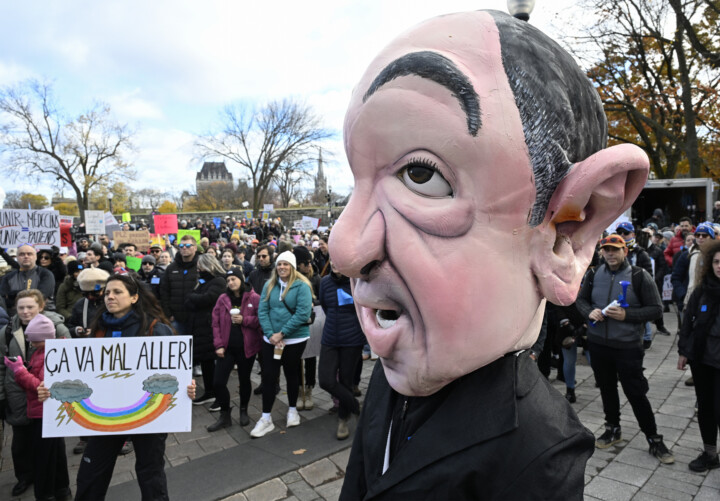Commissioner Paul Rouleau’s report on the federal government’s invocation of a public order emergency is an extraordinary document. It was produced on an exceptionally tight timeline following six weeks of sittings and clocks in at over 2,000 pages, including exhibits.
The nub of the report sees the judge concluding that Cabinet was justified in invoking the Emergencies Act on February 14, 2022: “There was credible and compelling evidence supporting both a subjective and objective reasonable belief in the existence of a public order emergency. The decision to invoke the Act was appropriate.” Its tone is cautious and measured. It is an exercise in pointed diplomacy and balancing, but perhaps wanting for clarity.
First: for Rouleau to have arrived at his conclusion, given the posture of federal Cabinet witnesses at the hearings, implies an extraordinary amount of deference to assiduously shielded government decision-making. The entire basis of Cabinet’s concern that the protests had evolved into an unmanageable situation remained opaque to the Commission. Attorney-General Lametti claimed that Cabinet, in invoking the Act, was acting on the basis of a legal opinion that held that “threats […] to the security of Canada”, were met within the meaning of the Act. It was necessary to refer to this legal opinion because the overwhelming evidence from actors who were receiving on-the-ground intel from Ottawa was the contrary.
During the hearings, we heard that the director of CSIS had concluded the Act’s threshold of “threats to the security of Canada” was not met. We also heard leadership of the Ottawa Police Service, the Ontario Provincial Police, and the RCMP, state that existing criminal law tools were sufficient. No other threat assessment or assessment of the inadequacy of existing legal authorities was performed independently of the country’s law enforcement. There was virtually no substantive basis upon which Cabinet could have concluded that the circumstances in Ottawa met the threshold for invoking the Act.
This opaqueness led to one of the more memorable exchanges of the Commission, when Commission counsel Gordon Cameron demurred at the conclusion of Lametti’s evidence: “Commissioner Rouleau, commission counsel is in a conundrum. We have attempted to find a way to lift the veil that has created such a black box around what has turned out to be a central issue before the hearing.”
Indeed, the issue of assessing the reasonableness of Cabinet’s decision was the whole crux of the matter. Rouleau then addressed Attorney General Lametti directly: “I’m having a little trouble… how we assess reasonableness when we don’t know what [Cabinet decision-makers] were acting on. Do we just presume good faith?”
Lametti was happy to affirm this, and judging by Rouleau’s conclusion, “presuming good faith” indeed turned out to be sufficient for his conclusion.
A requirement for invoking the Act is that it is a measure of last resort, specifying that “The emergency could not be effectively dealt with by any other federal law.” (Emphasis added.)
The report emphasizes the word “effectively”, calling it an “important modifier”, and seems to confuse this requirement that all other avenues of action be exhausted with a sort of argument of convenience:
There may be situations where other federal laws could technically apply to a situation, but still fall short. Practical considerations must be taken into account, such as whether the resources exist to enforce existing authorities, whether they would be effective in resolving the situation in a timely way, and whether they would address the situation safely.
Evidence of law enforcement was that, at best, the boost provided by the Emergencies Act was helpfulI’ve yet to meet a cop who didn’t welcome enhanced enforcement powers. but did not substantively alter a plan to clear the protests that already was in place by February 13, 2022, in advance of the invocation of the Act to clear the protest using existing policing powers.
Laws under the Criminal Code gave law enforcement the tools it needed—and ultimately used—to clear disruptive protests, compel tow truck operators to remove illegally parked trucks, and call in reinforcement police forces from across the country.The Ontario Civilian Police Commission could have directed the OPS Board to cede control of policing in Ottawa to the OPP. Under the RCMP Act, the RCMP commissioner could have deployed the RCMP to Ottawa to enforce the federal Criminal Code. Furthermore, Ontario itself could have invoked its own provincial Emergency Management Act to order the evacuation of Wellington Street and Rideau/Sussex. The report both acknowledges and dismisses this: “Although there continued to be laws such as the Criminal Code that, if effectively used, could bring the protests under control, it was apparent that law enforcement had serious reservations.”
Really? Not a single law enforcement witness testified that they requested the invocation of the Act, nor that they needed more tools than those already at their disposal.

Rouleau is harshly critical of the Ottawa Police Service in general and of former Chief Peter Sloly in particular, citing breakdowns in communication, incident command, and even a system to ensure its own intelligence reports were disseminated.On Sloly, he is casually devastating: “It seemed to some people, with some justification, that Chief Sloly was too willing to attribute blame to others, while avoiding any blame himself.” Ouch. All of this appears to be justified criticism. But using his findings about chaos amongst law enforcement, and a type of insufficiency of state capacity to effectively respond to crisis, to bootstrap the invocation of emergency powers sets a lamentable, even dangerous, precedent.
Finally, the report wholly accepts the federal government’s coup de grâce legal argument—that although the Emergencies Act definition of “threats to the security of Canada” incorporates the meaning within the CSIS Act, “two different decision-makers, each interpreting the same words in the context of different statutes, can reasonably come to different conclusions as to whether the threshold is met.”Jody Thomas, the prime minister’s national security and intelligence advisor, first presented this theory in the Ottawa hearings, stating that the CSIS Act’s definition of a threat to national security was “narrow” and did not apply to the Emergencies Act and that the convoy posed a threat to national security, but steadfastly refused to define what a threat to national security is.
This argument is dangerously misguided. It clearly strains the well-documented intention of Minister Perrin Beatty and the drafters of the Act in specifying that the definition of “threats to the security of Canada” is the same as that of the CSIS Act, right in the text of the statute. The standard was intended to be, in Beatty’s words, “very stringent, indeed.” But this argument truly goes from misguided to entirely untenable when one considers that we heard evidence from each of the relevant inputs who would have been aware of the on-the-ground situations—and not a single one testified that a threat to national security existed.Perhaps because of all of the hand-wringing surrounding the incorporation of the CSIS Act definition of threats to the security of Canada” into the Emergencies Act, Rouleau proposes that the Act be amended to eliminate this link because “the adoption of the CSIS definition “accords outsized importance to CSIS’ determination.” This acknowledgment seems to undermine his own finding that the two determinations are separate. Moreover, the link to the CSIS Act was deliberate in demanding more than merely the subjective opinion of the Governor in Council. As Beatty explains in the Act’s parliamentary debates, “[…] a step of such far-reaching implications as a national emergency should be based on a more objective foundation than the opinion of the Governor in Council.”
The report accords Cabinet a wide ambit of reasonableness in invoking the Act that is thoroughly unsupported by the statute’s strict definition. The justice doesn’t quite find that an actual situation presenting threats to national security had crystallized: in his conclusion, he writes that “the situation [Cabinet] was facing was worsening and at risk of becoming dangerous and unmanageable.” In other words, there was a whiff of danger in the air—Rouleau makes a great deal out of the Diagolon paraphernalia recovered at Coutts, Alberta, inferring that it might suggest similar ideologically motivated extremist actors might materialize in Ottawa (no policing witness testified that there was any evidence of such a presence, and Rouleau acknowledges no such links were found)—and, fearful of that whiff of danger, Cabinet was reasonable in invoking emergency powers.
This scope of latitude and deference is the appropriate standard for assessing on-the-ground, contingent actions of police—who, indeed, we rightly accord wide operating bandwidth. However, the same standard is wholly inappropriate for a sitting, properly briefed Cabinet’s sober deliberations in the face of a well-established and rightfully high legal threshold for invoking extraordinary powers to detain peaceful protestors, freeze bank accounts without due process, and suspend insurance throughout all of Canada.
A federal court judicial review, brought independently (unlike the Commission, which was convened and appointed by government), of the invocation of the Act remains pending. That decision will carry the binding force of law, unlike the Commission report. The matter is not yet finished, and there may yet be consequences for the government’s actions.
Recommended for You

The AI boom must not worsen Alberta’s urban-rural divide

Québec understands the health-care status quo is failing. When will the rest of Canada?

Premier Legault’s health-care gamble is alienating Québec doctors—but will it pay off with voters?

Canada is at a breaking point—the growing generational gap is a big reason why




